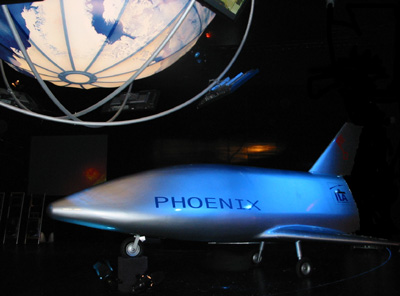Install the app
How to install the app on iOS
Follow along with the video below to see how to install our site as a web app on your home screen.
Nota: This feature may not be available in some browsers.
Je gebruikt een verouderde webbrowser. Het kan mogelijk deze of andere websites niet correct weergeven.
Het is raadzaam om je webbrowser te upgraden of een alternatieve webbrowser te gebruiken.
Het is raadzaam om je webbrowser te upgraden of een alternatieve webbrowser te gebruiken.
FORUMLEDEN met NOSTALGIE......"vreemde" kisten
- Topicstarter steffe
- Startdatum
- Status
- Niet open voor verdere reacties.
prop-er zei:
Er staan wel reacties in dit onderwerp....
welke reacties??? :wink: :wink: :wink:
steffe

Phoenix is the prototype of a European vehicle for reusable launchers and may even support manned space flight.
It can be flown atop the Ariane 5 or may be launched using other techniques. The project is for non-military usages and will probably be part of ESAs next vehicle. (Phoenix was, besides Penelope and Ariane, originally suggested for the name of Ariane rocket family.)
Phoenix is designed to be more economical than todays space vehicles and even reliable for manned space operations.
For conventional rockets, like the Ariane, the costs to launch 1 kilogram of payload weight into orbit can be up to $25.000 (per kilo).
In the first few decades of the 21st century, it will be the first independent manned European non-military attempt at space operations and will be an important part of the ISS project. (Compare Vostok 1.)
It is anticipated that the production craft will enter use between 2015 and 2020.
Phoenix is part of the German national program ASTRA, a $40 million project founded by the German Federal Goverment, EADS Space Transportation and the State of Bremen with one third each.
Both EADS and the State of Bremen have already invested another $8.2 million respective $4.3 million out of own funds. Another contribution of 16 million euros comes from partner companies such as the Bremen-based OHB, DLR and the Federal Ministry for Education and Research.
EADS is responsible for the project management and for the entire software equipment of the system. Other partner companies are also involved in the development.
The Phoenix RLV prototype is 6.9 meters long (23'), has a weight of 1,200 kilograms (2,640 lbs), and a wingspan of 3.9 meters (13').
The prototype, at one seventh the size of the planned vehicle, is still in the alpha stage of development at Bremen labs of EADS.
On Saturday 8 May 2004 the prototype was dropped from 2.4 kilometers (8,000 feet) by a helicopter and landed precisely and without incident after a GPS-guided 90-second glide.
The test was conducted at the North European Aerospace Test range in Kiruna, 1,240 km (770 miles) north of Stockholm, Sweden. Future tests will involve drops from higher altitude, possibly from a balloon.
The primary aim of the test was to assess the glider potential of the craft. The final version of the vehicle must be able to glide from an altitude of 129 kilometers (80 miles).
Airbus zei:ruimtevaart is me vak niet :lol:
@ dirk57 Next graag
Dit was een illegale opgave. Degene die echt aan de beurt is, is andere Dirk, die wel veel verstand heeft van vliegtuigen.
prop-er zei:
Er staan wel reacties in dit onderwerp....
Ben hier vanmiddag mee bezig geweest en heb wat getest, ziet er bij mij goed uit, nu kijken of het opgelost is.
Robert
prop-er
Forum veteraan
Beste Robert,
Zo wordt je natuurlijk nooit lekker bruin... :wink:
In de door MBF verzonden abo mail staat de link:
http://www.modelbouwforum.nl/phpBB2/viewtopic.php?p=747492#747492
Deze geeft bij mij opnieuw de "geen reacties" bug.
Prop-er
Zo wordt je natuurlijk nooit lekker bruin... :wink:
In de door MBF verzonden abo mail staat de link:
http://www.modelbouwforum.nl/phpBB2/viewtopic.php?p=747492#747492
Deze geeft bij mij opnieuw de "geen reacties" bug.
Prop-er
In het mailtje kwam nu de mededeling, dat het onderwerp of het bericht, dat je zoekt niet bestaat. Dit is een andere mededeling dan voorheen. Bij 'nieuwe berichten' was 't ie overigens wel aanwezig.
Eerst eens afwachten tot het 15e bericht op de pagina is geplaatst en dan kijken of de paginateller het nu wel goed doet...
Eerst eens afwachten tot het 15e bericht op de pagina is geplaatst en dan kijken of de paginateller het nu wel goed doet...
prop-er
Forum veteraan
rafgol zei:Nog zo'n illegale opgave, nee, ik weet zelf niet wat het is, lijkt een heli alleszins...



A160 Hummingbird
The A160 Hummingbird UAV looks like a helicopter but is unlike any other helicopter. It can reach higher altitudes, hover for longer periods of time, go greater distances and operate much more quietly than current rotorcraft. With its unique optimum-speed rotor technology, the Hummingbird adjusts rotor RPM to optimize performance at different altitudes and cruise speeds.
The aircraft addresses current and emerging requirements of the U.S. armed forces, the U.S. Department of Homeland Security, and international military and security organizations. Missions for the A160 include reconnaissance, surveillance, target acquisition, communications relay and precision resupply.
A Phantom Works IDeAS team called Advanced Unmanned Systems–Concept Exploration is developing the A160 with the government. The Hummingbird is designed to fly 2,500 nautical miles (4,630 kilometers) with endurance in excess of 24 hours and a payload of more than 300 pounds (136 kilograms). It is intended to fly at an estimated top speed of 140 knots (259 kilometers per hour) at ceilings above 15,000 feet (9,100 meters). Through mid-April 2005, three A160s had completed 27 test flights for 34 hours of flight time.
prop-er
Forum veteraan
Corrien zei:Hij doet 't nu inderdaad weer normaal 8O 8) !
The X-5 was the world's first airplane to vary the sweepback of its wings in flight. Its first flight was on June 20, 1951
He, ja, goed dan, ik bedoel natuurlijk, het eerste gevechtsvliegtuig met variabele sweep....
- Status
- Niet open voor verdere reacties.

